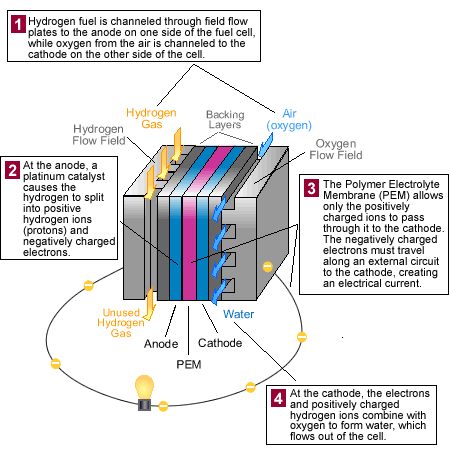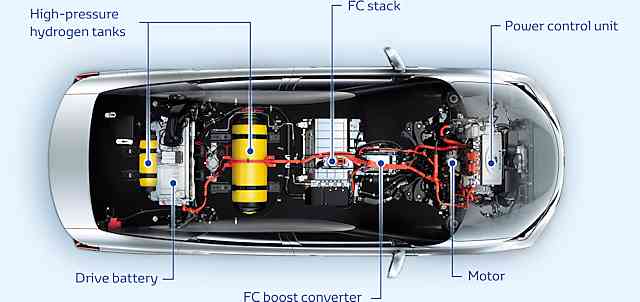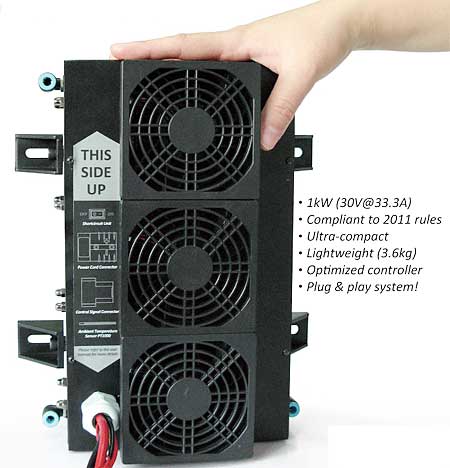Hydrogen Fuel Cells
Hydrogen fuel cells are what will power the ‘Hydrogen Highway’ of the future. Hydrogen fuel cells are electrochemical engines that come in several different varieties with the most common being the Proton Exchange Membrane (PEM) fuel cells, also called Polymer Electrolyte Membrane fuel cells. PEM fuel cells use oxygen from the air and pressurized hydrogen to create electricity, heat and water (steam) as byproducts.
The sketch below from the Department of Energy shows the different parts of a PEM fuel cell used to power hydrogen cars.

Hydrogen Fuel Cell depicted by Department of Energy
Most hydrogen fuel cells do not produce enough voltage to power a car so fuel cells are typically arranged in “fuel cell stacks.” Because of recent engineering advances, a hydrogen fuel cell that is about the size of a small piece of luggage can power a car.
The difference between hydrogen fuel cells and typical batteries is that batteries eventually go dead. The hydrogen fuel cell keeps going as long as hydrogen and oxygen are introduced to the cell, producing electricity continuously.
The hydrogen car’s electric induction motor/transaxle and electric power inverter will use the electricity generated from the PEM fuel cells to produce up to 90 kilowatts of power. The inverter turns the direct current (DC) into alternating current (AC) which can then power the electric motor that turns the wheels of the car. Most likely, other features of the car like air conditioning and electrical system will still be powered by a traditional car battery.

Toyota Fuel Cell Stack Plus other Components
Very Common …
Hydrogen is the most common element in the universe and hydrogen can come from many readily available sources for fuel cell use. Sources such as methanol, ethanol, natural gas, biomass (plants and trees), waste gases from landfills and water treatment plants, sunlight, wind and geothermal energy sources can all be used to produce hydrogen fuel for FCVs.
Besides fuel economy and lessening pollution, hydrogen fuel cell cars have a few other benefits as well. Lower maintenance costs from less moving parts, lighter weight vehicles for less wear and tear on parts, longer driving range, less engine shake for quieter, smoother ride, and plenty of power for entertainment features such as Internet connections, GPS and DVD movie players are a few of the added benefits of having a hydrogen fuel cell powered car.
|
This photo is an example of a light weight Horizon hydrogen fuel cell.
|
 Horizon Hydrogen Fuel Cell |
A company out of Milan, Italy called Nuvera Fuel Cells, Inc. has announced a breakthrough in its Andromeda II fuel cell stack. This new second generation technology is capable of generating 125 kW of power (168 horsepower). It also exceeds milestones for milestones for power density, cold-start capability, system efficiency, durability, and high-volume production cost.
The U. S. Department of Energy announced that in 2008 there were two new breakthroughs in the technology behind hydrogen fuel cells. First, the price has come down around 23-percent because of the use of less platinum. Second, the durability of cells by 3M has increased from 5,000 operating hours to 7,300 hours exceeding the DOE target.
The price of fuel cells keeps coming down. One of the goals of many researchers is to create platinum-free fuel cell that have the same power and durability, but at one quarter the cost. Nickel, cobal, carbon nanotube technology or even biological fuel cells have been created in order to reduce or eliminate costly platinum.
It’s only a matter of time until platinum is replaced in fuel cells with material that is less costly, more durable and just as effective in producing power.
More Information From Our Blog
Written by Hydro Kevin Kantola